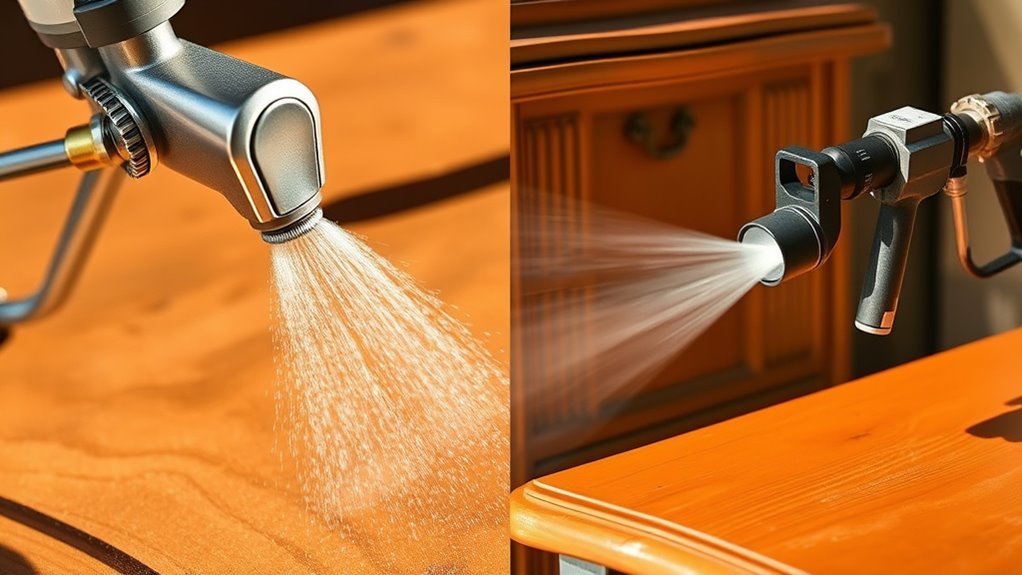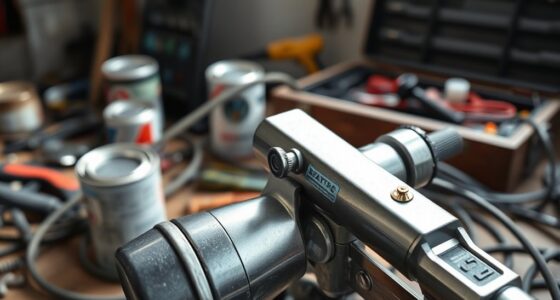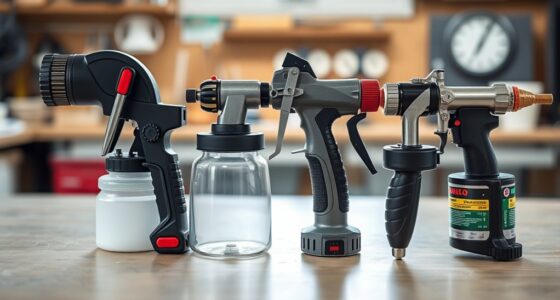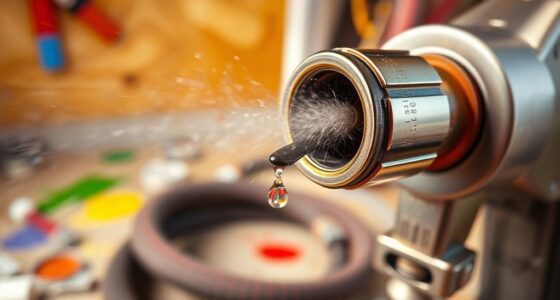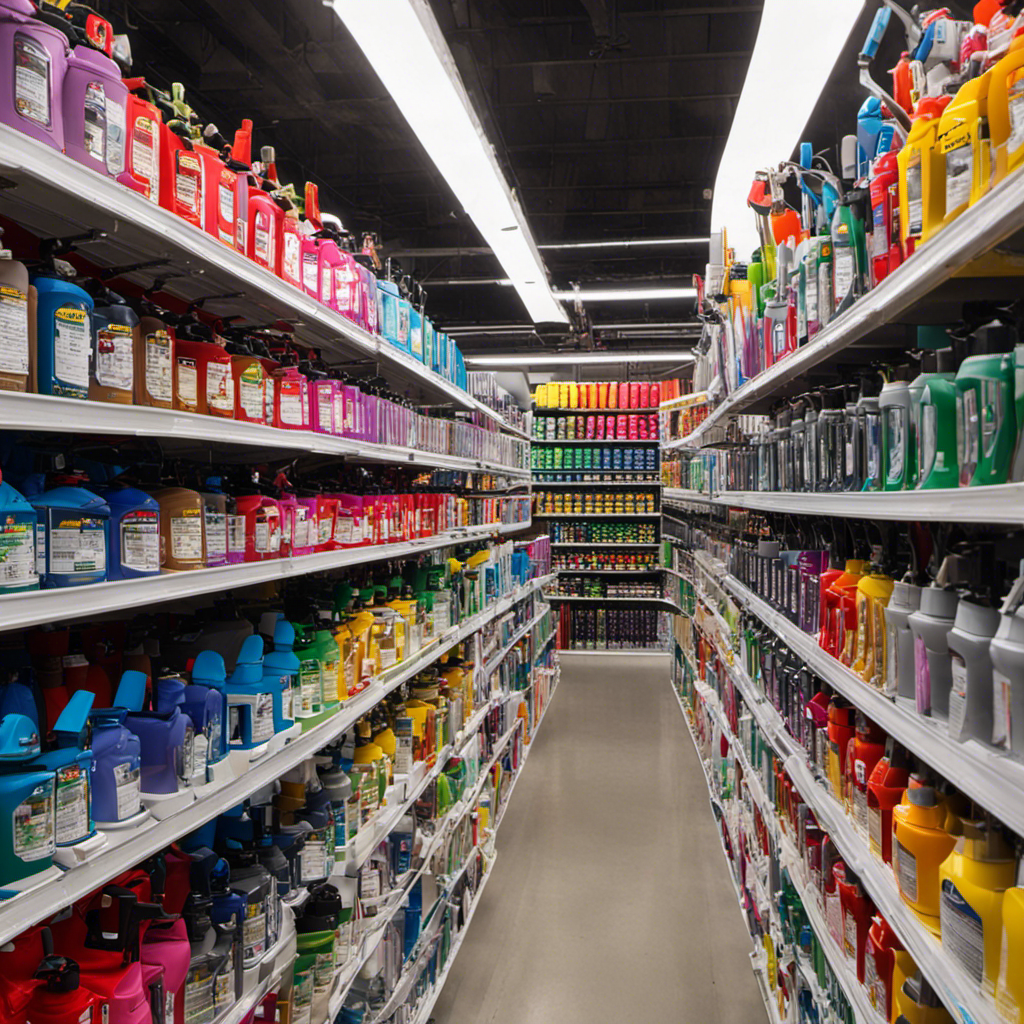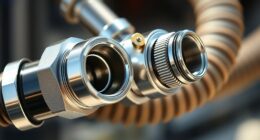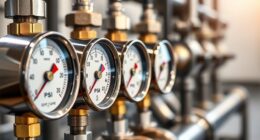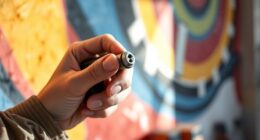If you’re choosing between HVLP and airless sprayers for furniture, consider your project size and detail needs. HVLP offers precise control with minimal overspray, making it ideal for delicate or intricate finishes. Airless sprayers cover large surfaces quickly but can be harder to control. Your choice depends on your budget, skill, and finish quality goals—exploring more can help you pick the best tool for your furniture projects.
Key Takeaways
- HVLP offers precise control and minimal overspray, making it ideal for detailed furniture finishing and delicate surfaces.
- Airless sprayers provide faster coverage for large furniture pieces but require more skill to manage spray pattern and prevent drips.
- HVLP systems are typically more budget-friendly, easier to operate, and suitable for beginners or small-scale projects.
- Airless equipment is better for large projects needing quick application, though it involves higher initial costs and more maintenance.
- HVLP is more environmentally friendly with higher material efficiency, while airless produces more overspray and waste.
Understanding the Basics of HVLP and Airless Spray Systems

To understand the differences between HVLP and airless spray systems, it’s important to grasp how each one operates. HVLP systems use a high volume of air at low pressure, delivering fine, controlled spray patterns ideal for detailed furniture work. They require careful spray gun calibration to ensure even paint distribution and prevent drips. In contrast, airless systems pump paint at high pressure through a nozzle, creating a powerful, rapid spray suitable for larger surfaces. Unlike brush painting, which is slower and more labor-intensive, spray systems cover surfaces quickly and uniformly. While HVLP offers precision, airless systems excel in speed. Additionally, portable power sources are often necessary to operate these systems effectively in various settings. Understanding these basics helps you choose the right tool for your furniture projects, balancing detail and efficiency effectively. Proper technique also plays a crucial role in achieving professional results with either system. For example, mastering spray distance can significantly impact the quality of your finish. Recognizing the differences in paint flow control between the two systems can help optimize your application process, and being aware of paint viscosity is essential for achieving a smooth, even coat.
Differences in Operation and Mechanism
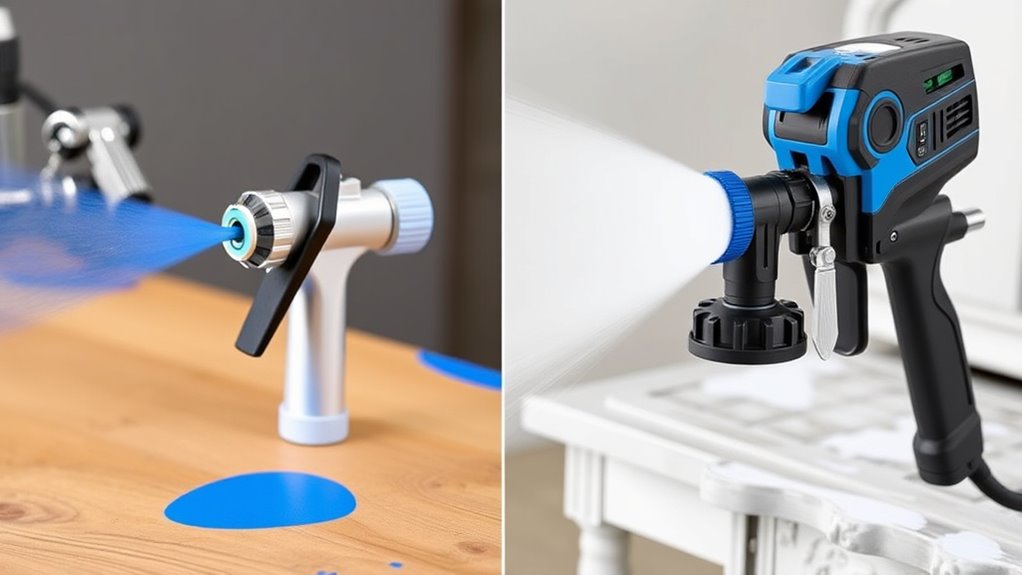
You’ll notice that HVLP and airless sprayers operate differently because of their spray technology mechanics. HVLP uses high volume and low pressure to atomize paint gently, while airless spray systems rely on high pressure to push paint at a fine mist. Understanding how airflow and pressure work in each system helps you choose the right tool for your furniture projects. Additionally, proper application techniques are essential to ensure an even and professional finish when using these sprayers.
Spray Technology Mechanics
HVLP and airless spray systems operate through fundamentally different mechanisms that influence how paint is delivered onto furniture surfaces. HVLP uses high volume, low pressure to atomize paint into a fine mist, allowing you to control spray patterns easily and reduce overspray. This system often requires you to master brush techniques and precise paint mixing to achieve smooth, even coats. In contrast, airless sprayers force paint at high pressure through a small nozzle, creating a powerful stream that covers large areas quickly. With airless, you don’t need to worry much about brush techniques, but proper paint mixing is essential for consistency and to prevent clogging. Understanding these mechanics helps you choose the right system and technique for your furniture painting project. Additionally, tuning options for vehicles like Kia Sedona or Kia Forte can optimize performance, much like selecting the appropriate spray system ensures a high-quality finish in furniture painting. The atomization process directly impacts the smoothness and quality of the final coat, making it crucial to understand which system suits your specific needs. Moreover, mastering paint flow regulation can significantly improve your results, regardless of the spray technology you choose. Properly adjusting air pressure is vital for achieving the desired spray pattern and finish quality in both systems.
Airflow and Pressure
HVLP and airless spray systems differ markedly in how they generate and control airflow and pressure during application. With HVLP, airflow dynamics are designed to produce a high volume of air at lower pressure, allowing for precise control and minimal overspray. Pressure regulation is crucial here, ensuring consistent atomization and a smooth finish. In contrast, airless sprayers operate at very high pressure, pushing paint through a nozzle to create a fine spray. Their airflow is less about volume and more about force, delivering thicker coats quickly. This difference influences how you manage pressure regulation: HVLP needs careful adjustments for fine detail, while airless systems rely on high pressure to cover large surfaces efficiently. Understanding these mechanisms helps you choose the right tool for your furniture project. Additionally, the technology behind automation in these systems continues to evolve, offering even more precise control and efficiency for painters. Innovations such as digital pressure controls are making it easier to fine-tune spray patterns and reduce waste.
Cost Comparison and Budget Considerations
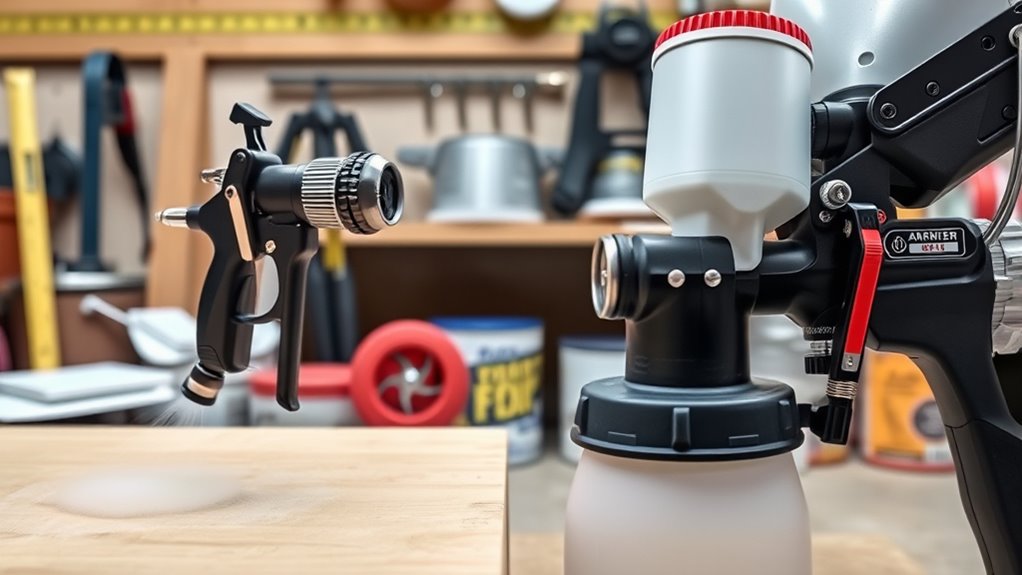
When comparing the costs of HVLP and airless sprayers for furniture painting, it’s important to contemplate both initial investment and ongoing expenses. In a price comparison, HVLP systems generally cost less upfront, making them appealing if you’re on a tight budget. Airless sprayers tend to have higher initial prices, but they can cover larger projects faster, potentially saving you money in the long run. Budget planning should consider maintenance costs, replacement parts, and paint consumption. HVLP sprayers usually require less paint and have lower maintenance costs, which can be more economical over time. Additionally, understanding the investment considerations involved can help you make a more informed decision. For example, the choice between these systems can also depend on the painting techniques you plan to use and the level of finish desired. Proper technique mastery can significantly impact the quality of your results and efficiency. It’s also worth noting that paint application quality varies between systems, affecting how professional your final furniture finish appears. Ultimately, your choice depends on your project size, frequency, and financial flexibility. Balancing initial costs with ongoing expenses helps ensure you make a cost-effective decision.
Ease of Use and Learning Curve
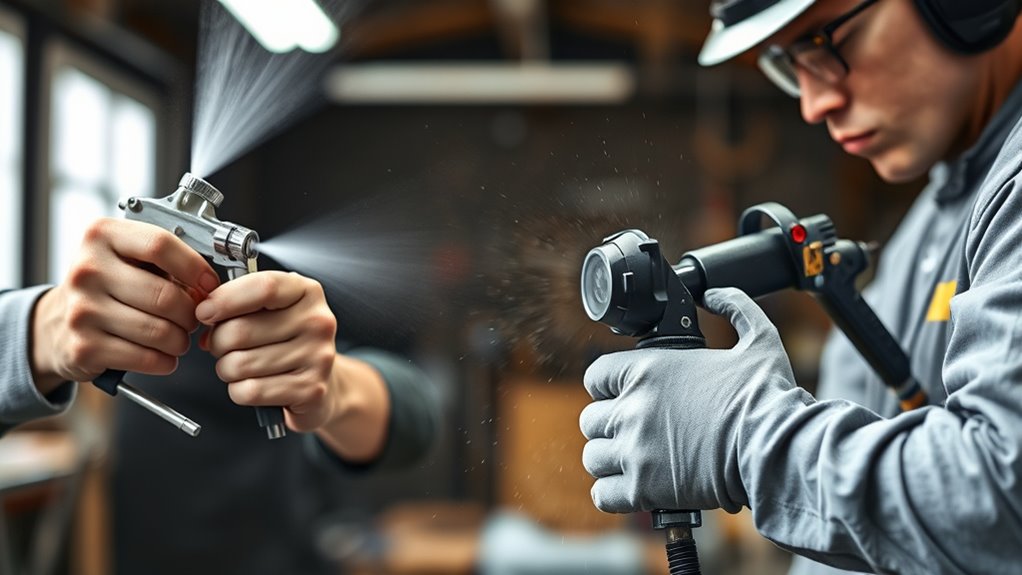
Although both HVLP and airless sprayers are effective tools, their ease of use varies considerably. HVLP sprayers generally have a gentler learning curve because they require less pressure and are more forgiving with brush techniques, making them ideal for beginners. They also benefit from being used in a spray booth, which helps contain overspray and simplifies cleanup. Additionally, understanding toilet maintenance and repairs can help users troubleshoot common issues that may arise with equipment, making the overall painting process smoother. Moreover, HVLP sprayers are often more suitable for detailed furniture work because of their lower pressure and finer spray pattern, allowing for greater control and precision. A proper setup and calibration of the sprayer can significantly influence the ease of use and quality of the finish, especially for those new to spray painting. For example, some models like the Vetted Flat Iron Bike kits demonstrate the importance of consistent power output for reliable results. Airless sprayers, on the other hand, deliver higher pressure, which can be challenging for new users to master. They require more careful control of the spray pattern and technique, especially for detailed furniture work. While both tools can produce professional results, HVLP sprayers tend to be easier to operate initially, whereas airless sprayers demand more practice to achieve consistent, high-quality finishes.
Material Efficiency and Spray Pattern Quality
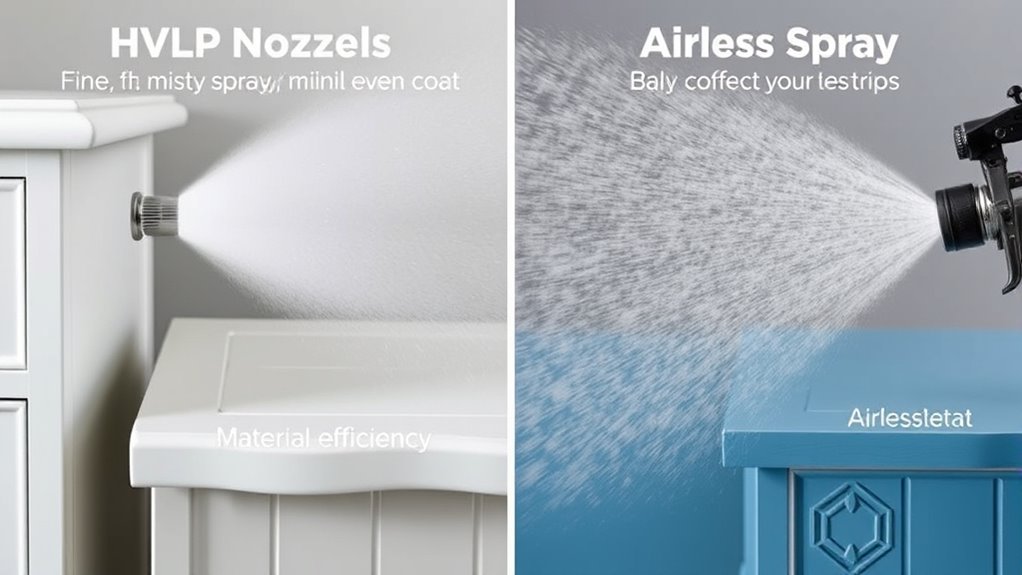
Material efficiency and spray pattern quality substantially influence the overall effectiveness of your furniture painting. With HVLP systems, you typically get better control over paint consistency, reducing waste and ensuring more precise application. The spray pattern from HVLP tends to be broader and more uniform, which helps you achieve a smooth, even finish without overspray. If you want to maximize material efficiency and maintain a consistent spray pattern, HVLP is usually the better choice. It allows you to use less paint while achieving high-quality results, making your furniture look flawless with less material expense. Additionally, HVLP systems are often designed with efficient filtration options to help maintain air quality during use. Properly calibrating your equipment can further optimize spray performance and ensure a professional finish. According to support hours, proper ventilation and equipment maintenance can further enhance your painting experience.
Suitability for Different Types of Furniture Projects
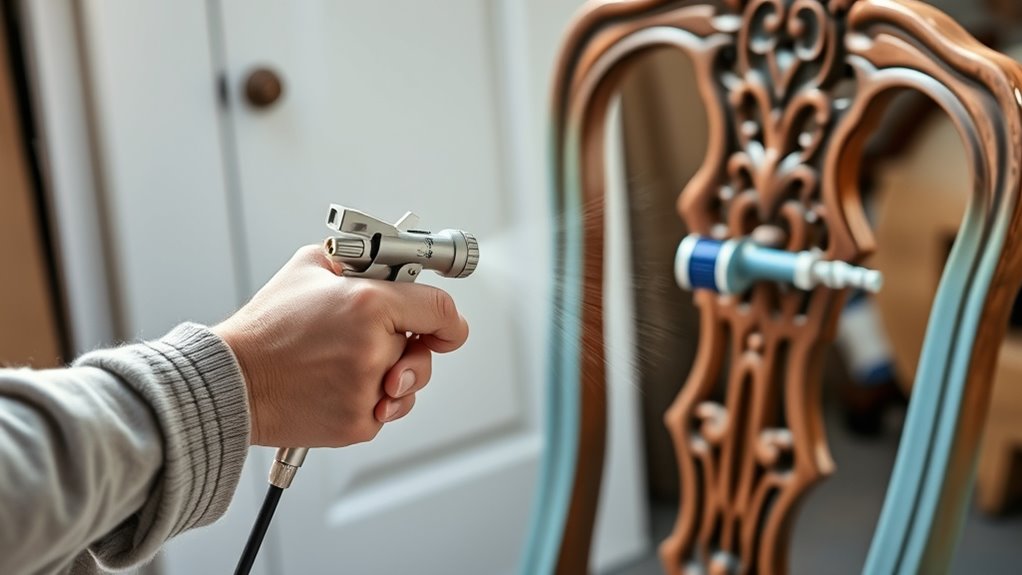
Choosing the right sprayer depends on the size and complexity of your furniture project. For small, detailed work like custom furniture or antique restoration, HVLP is ideal because it provides fine control and smooth finishes. Airless sprayers are better suited for larger pieces, such as dining tables or cabinet sets, where speed and coverage matter. Consider this comparison:
| Project Type | Recommended Sprayer |
|---|---|
| Custom furniture | HVLP |
| Antique restoration | HVLP |
| Large furniture pieces | Airless |
If you need precision and minimal overspray, HVLP is your go-to. For faster coverage on bigger projects, airless sprayers excel. Match your choice to your project’s scope for the best results.
Coverage Area and Speed of Application

When it comes to covering large surfaces quickly, airless sprayers generally outpace HVLP models thanks to their higher flow rates and broader spray patterns. This means you can complete furniture projects faster without sacrificing coverage. However, the increased flow can impact spray pattern accuracy, making it harder to control fine details. Consider these points:
- Airless sprayers deliver a larger coverage area in less time, ideal for big furniture pieces.
- HVLP sprayers offer better spray pattern accuracy, allowing for precise, detailed finishes.
- Noise levels tend to be higher with airless models, which might be a concern in quieter environments.
Choosing between them depends on your project size, desired finish, and comfort with noise and spray control.
Maintenance and Cleaning Requirements
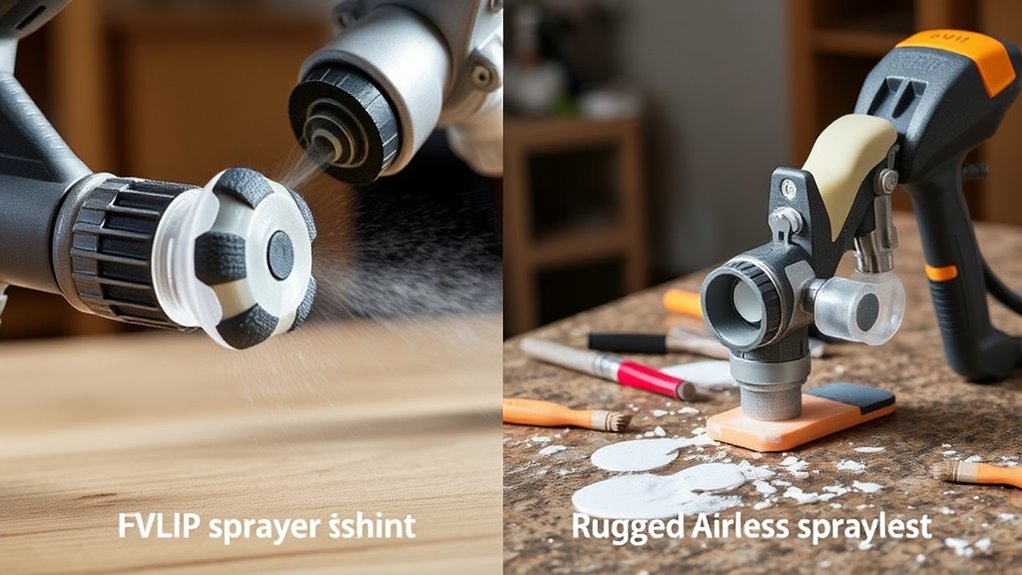
Airless sprayers typically require more maintenance and thorough cleaning after each use to prevent clogging and guarantee consistent performance. You should follow specific cleaning procedures, such as flushing the system with water or solvent, to remove residual paint. Regular maintenance routines include inspecting and replacing filters, checking hoses for wear, and ensuring the pump operates smoothly. Skipping cleaning can lead to blockages that impair spray quality and damage the equipment. Properly cleaning your sprayer after every project extends its lifespan and maintains ideal function. While airless units demand more effort, diligent maintenance routines can simplify ongoing care. In contrast, HVLP sprayers generally require less intensive cleaning, making them more convenient for frequent use.
Environmental Impact and Overspray Control
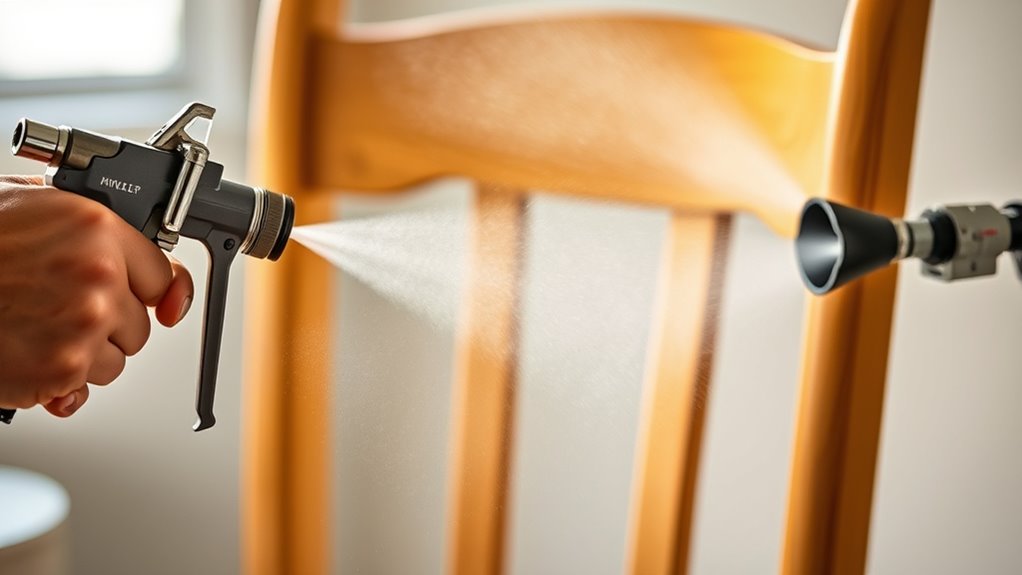
Environmental impact and overspray control are crucial considerations when selecting a paint spraying method. Choosing eco-friendly options reduces harmful emissions and waste. With HVLP, you get:
HVLP offers eco-friendly paint application with less overspray and noise reduction for sustainable, cleaner projects.
- Less overspray, minimizing paint waste and cleanup.
- Quiet operation, offering noise reduction and less disturbance.
- Higher transfer efficiency, which means more paint reaches the surface and less ends up in the environment.
Airless sprayers tend to produce more overspray, increasing paint waste and environmental impact. They also generate more noise, making them less suitable for noise-sensitive areas. By focusing on eco-friendly options and noise reduction, HVLP systems help you paint more sustainably while maintaining a cleaner workspace. This balance makes HVLP a better choice for environmentally conscious furniture painters.
Choosing the Right System for Your Furniture Painting Needs
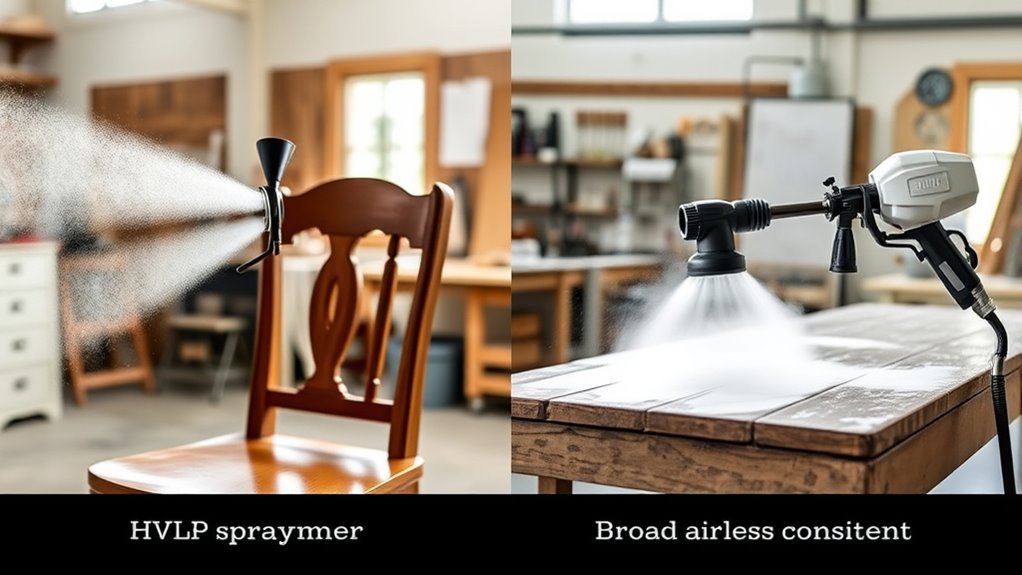
Choosing the right system depends on your priorities for surface finish quality and application ease. HVLP often provides smoother, more controlled results, while airless sprayers cover large areas quickly. Consider which aspects matter most to you to make the best choice for your furniture projects.
Surface Finish Quality
When it comes to achieving a smooth, professional-looking finish on your furniture, the type of spray system you select makes a significant difference. HVLP systems excel at providing superior finish smoothness and texture uniformity because they produce a gentle, fine spray that minimizes overspray and drips. In contrast, airless sprayers deliver a high volume of paint quickly, which can sometimes result in uneven texture if not controlled properly. Consider these points:
- HVLP offers consistent finish smoothness, ideal for detailed or delicate furniture pieces.
- Airless systems can achieve a uniform texture at high speed, suitable for larger surfaces.
- Your choice influences surface quality, so match the system to your desired finish and project scope.
Choosing wisely ensures your furniture looks flawless with minimal touch-ups.
Application Ease
Selecting the right spray system can markedly simplify your furniture painting process. HVLP sprayers generally require less setup and are easier to control, making application smoother. You’ll want to master simple brush techniques for areas that need detail or touch-ups, but overall, spray systems reduce the need for complex brushwork. Proper paint mixing is essential to guarantee consistent flow and avoid clogging, especially with HVLP systems. Airless sprayers cover large surfaces quickly, but they demand more effort in adjusting pressure and maintaining an even spray pattern. If you prefer a straightforward, less intimidating approach, HVLP offers a more user-friendly experience. Whichever system you choose, practicing your techniques and preparing your paint properly will help you achieve a flawless finish with less frustration.
Frequently Asked Questions
Which Spray System Produces the Smoothest Finish for Furniture?
You want the smoothest furniture finish, so focus on your spray nozzle and paint viscosity. A fine spray nozzle helps atomize paint better, resulting in a smoother surface. Lower viscosity paints flow more easily, reducing splatters and uneven textures. By adjusting these factors, you can achieve a sleek, professional look. Keep your spray system well-maintained and experiment to find the perfect balance for your project’s desired finish.
Can HVLP or Airless Systems Be Used for Detailed Furniture Work?
Imagine a painter’s brush as a delicate brushstroke, guiding your vision. Both HVLP and airless sprayers can handle detailed furniture work, but their spray nozzles and paint viscosity matter. HVLP’s fine nozzle delivers precise control, perfect for intricate designs. Airless sprayers, with their robust flow, require thinner paint but can still handle detailed work with the right adjustments. Choose based on your detail level and paint consistency.
How Do Weather Conditions Affect Spray Application Quality?
Weather conditions considerably impact your spray application quality. High humidity can cause the paint to dry slowly, leading to runs or uneven coats, while low humidity helps achieve a smooth finish. Temperature effects also matter; if it’s too cold, the paint may thicken, making spraying difficult, and if it’s too hot, it can dry too quickly, causing imperfections. Always check weather forecasts to optimize your painting conditions for the best results.
Are There Safety Concerns Specific to HVLP or Airless Sprayers?
Safety is your guiding star when choosing between HVLP and airless sprayers. Like a cautious sailor, you must consider chemical exposure, ensuring proper masks and ventilation to avoid inhaling fumes. Electrical safety is also essential—inspect cords and connections regularly to prevent shocks. Both sprayers pose risks, but with careful handling and safety gear, you can protect yourself from hazards and enjoy a smooth, worry-free painting experience.
Which System Is More Suitable for Small DIY Furniture Projects?
For small DIY furniture projects, you’ll find HVLP sprayers more suitable because they offer better control and produce a smooth finish. Focus on using proper brush techniques and paint preparation to achieve professional results. HVLP systems use lower pressure, reducing overspray, making them ideal for detailed work. With careful prep and technique, you can easily enhance your furniture with a flawless coat, even if you’re new to spraying.
Conclusion
Ultimately, choosing between HVLP and airless sprayers depends on your specific furniture project and preferences. Think of it as finding the perfect dance partner—one that moves smoothly with your style and pace. Both systems have their charm, offering unique benefits that can make your furniture painting journey more enjoyable. Trust your instincts, experiment a little, and you’ll discover which tool helps turn your vision into beautiful reality with less fuss and more fun.
A seasoned painter with over 15 years in the industry, Mike transitioned from hands-on painting projects to the digital world of paint sprayers. His extensive experience gives him a unique perspective on what users truly need when it comes to painting tools. As the Editor in Chief of Paint Sprayer Zone, Mike ensures that every piece of content not only provides value but also reflects the realities of painting — the challenges, the joys, and the intricate details.
